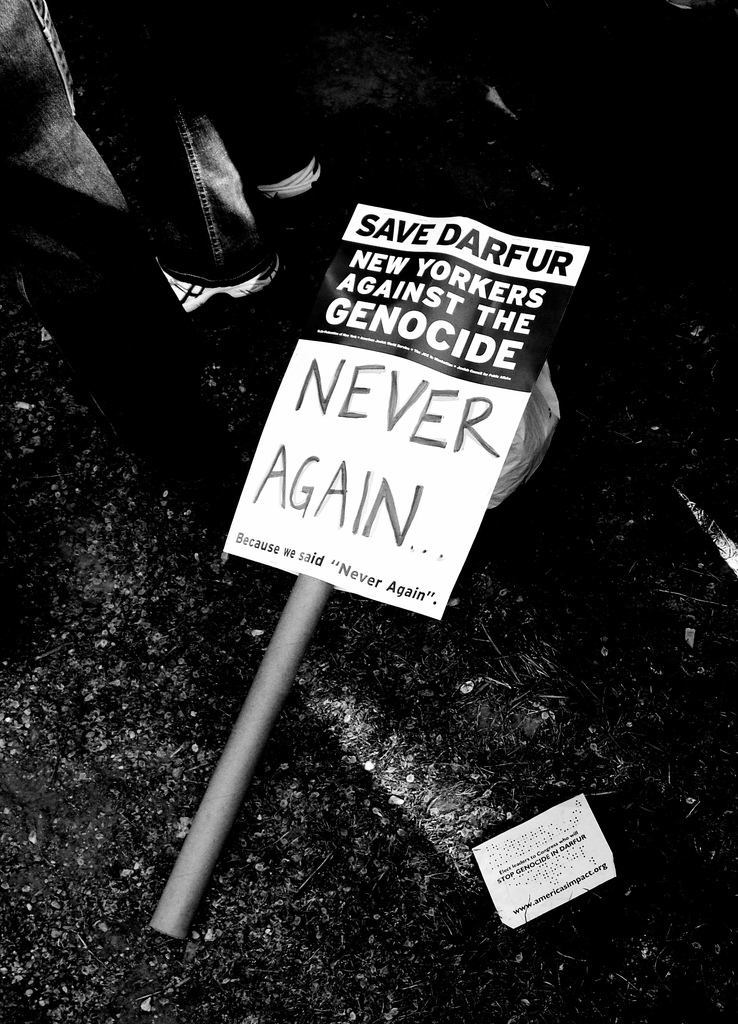Looking at the horrors of the Syrian Civil War, how can we so quickly have forgotten the lessons of Rwanda and Bosnia?
On March 28, 2011, President Barack Obama appeared on television screens across America and told his nation why he had authorized air strikes on Libyan government forces and installations.
“To brush aside America’s responsibility as a leader and—more profoundly—our responsibilities to our fellow human beings under such circumstances would have been a betrayal of who we are,” he said. “Some nations may be able to turn a blind eye to atrocities in other countries. The United States of America is different. And as President, I refused to wait for the images of slaughter and mass graves before taking action.”
Less than two weeks earlier, anti-government protests had begun in Syria, which would eventually deteriorate into the Syrian Civil War, now entering its third year. As peace talks between Syria’s Assad regime and opposition groups have failed, the international community’s already-waning focus must not shift even further from Damascus and the ongoing atrocities Syrian civilians continue to face.
The case for a limited U.S.-led intervention in Syria, without “boots on the ground,” is as relevant as it was a year ago, and is now compounded with copious evidence of war crimes committed by the regime. Meanwhile, historically unprecedented numbers of Islamist fighters continue to flock to Syria to wage jihad, deadly spillover in the form of suicide car bombings continues to rock Lebanon, and hundreds of thousands of refugees continue to starve in Syria and pour into neighboring countries.
The call for intervention is predicated on two arguments. One of them is strategic. Allowing Syria to continue in the political purgatory it has remained in for three years allows jihadi groups to continue flourishing. The assertion that both the Iran-backed Assad regime and radical Islamist factions should continue battling each other is as myopic as it is bereft of humanity: as the conflict rages on, with potentially hundreds of thousands more being killed and potentially spiraling into a full-blown genocide, both sides will benefit from increased resources, foreign fighters, and battle experience, while the spillover will continue to seep into neighboring countries with increasingly deadly repercussions, to the point where the strategic interests of the U.S. and its allies will inevitably be directly threatened—and both sides will feel emboldened by the manifest weakness of the West.
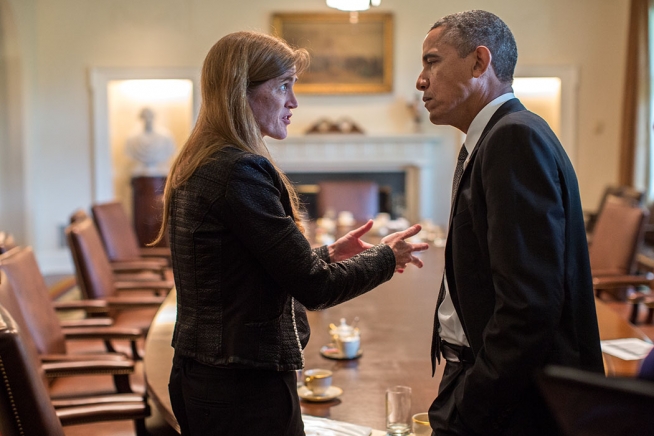
President Barack Obama talks with UN Ambassador Samantha Power following a Cabinet meeting, September 12, 2013. Photo: Pete Souza / flickr
The second—and the central focus of this essay—is the serious moral imperative to halt the bloodshed that has already claimed the lives of at least 140,000 people, displaced several millions more, and should shame the entire international community. The situation for Syrian civilians at this time is far, far worse than that of the Libyans in 2011; if there was a moral obligation to intervene in the former case, then there surely is in the latter today.
Following the failure of the international community to adequately react to the Rwandan genocide, which led to the massacre of upwards of a million people in only 100 days in 1994, a framework emerged that called on the international community to prevent crimes against humanity by all means necessary. The doctrine of the Responsibility to Protect (R2P), as outlined in the Outcome Document of the 2005 United Nations World Summit (which was unanimously reaffirmed by the UN Security Council the next year), and reiterated in the Secretary-General’s 2009 report on implementing this norm, is based on three pillars: That the State is the unit that is primarily responsible for protecting its own population from genocide and war crimes; that the international community remains obligated to supporting the State in fulfilling this responsibility; and that the international community
has a responsibility to use appropriate diplomatic, humanitarian and other means to protect populations from these crimes. If a State is manifestly failing to protect its populations, the international community must be prepared to take collective action to protect populations, in accordance with the Charter of the United Nations. [emphasis added]
The evidence that the Assad regime has indiscriminately used chemical weapons, blocked humanitarian aid, and systematically tortured prisoners is a very clear and willful violation of the first element of this norm. Because of this, the international community cannot very well protect Syrian civilians by cooperating with the very entity punishing them the most. Thus, the third point calling for the international community to intervene must remain a viable and credible option.
Though the Responsibility to Protect norm was developed in response to genocides and explicitly sectarian attacks, such as Saddam Hussein’s gassing of the Kurds in Iraq, the Rwandan genocide, and Slobodan Milosevic’s policy of ethnic cleansing in the former Yugoslavia, the framework still applies to generalized “crimes against humanity,” which Assad’s regime is well-documented in perpetrating, as we shall recount below. Besides, the war in Syria has become increasingly sectarian, and it cannot be ruled out that the current staggering death toll could, cruelly, only be a prologue to genocide. Neither does the fear of genocide need to be carried out by the Assad regime in order to justify an intervention—according to the doctrine, it only takes the regime’s “manifestly failing to protect its populations” to warrant it. In other words, genocidal operations by the opposition are relevant as well. And indeed, a UN report on Syrian children released in early February of this year indicated that several armed opposition groups carried out a mass killing targeting Alawite villages on August 4, 2013; at least 18 children were killed and an unknown number of other children were severely maimed. It is likely this type of targeted killing will not only persist but will increase as the conflict drags on.
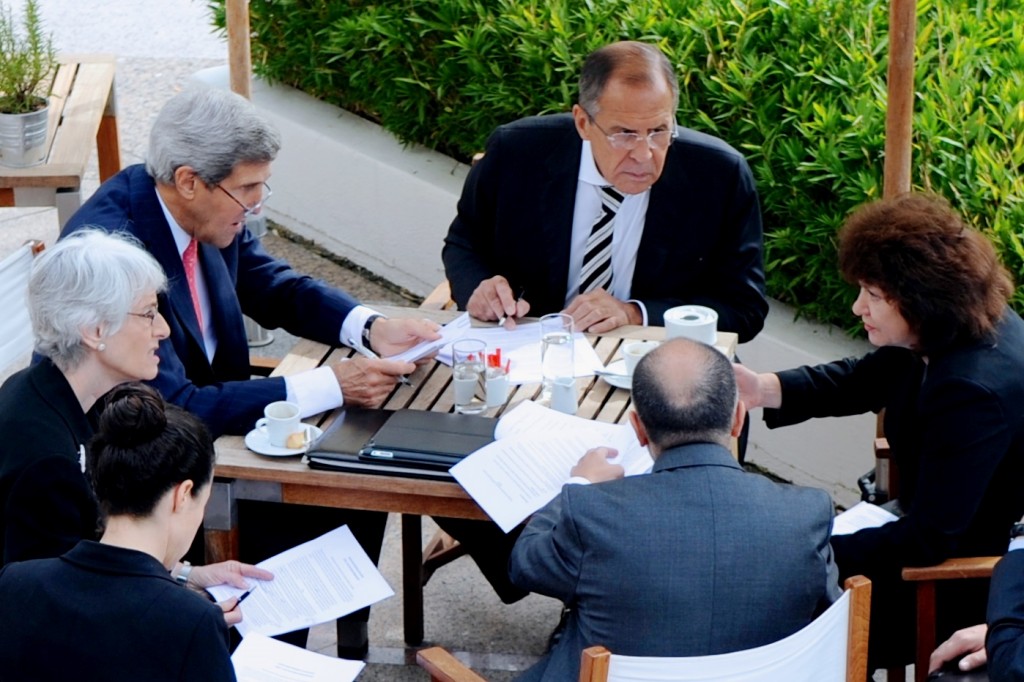
U.S. Secretary of State John Kerry and Russian Foreign Minister Sergey Lavrov, during final negotiating session over agreement to eliminate Syria’s chemical weapons. Geneva, Switzerland, September 14, 2013. Photo: U.S. Department of State / Wikimedia
The drawback to the R2P doctrine, at least as conceived by the UN as its own body, is that the legitimacy of humanitarian intervention is derived solely by acting “in accordance with the Charter of the United Nations,” which essentially means “with the authorization of the UN Security Council.” This, of course, would be preferable in all circumstances, but it would be both immoral and illogical to wait indefinitely for such approval, especially if the relevant resolution is toothless or hamstrung. UN peacekeeping forces are often limited by those resolutions in their ability to adequately respond to atrocities (as was the case in Rwanda, where UNAMIR’s rules of engagement were limited mostly to “monitoring,” as well as the infamous abandonment of Srebrenica in Bosnia by UN forces in advance of marching murderous Serbs in 1995). UN forces can only enter a country with the consent of its ruler, a loophole the Sudanese government exploited as it continued its atrocities in Darfur—the first time a UN peacekeeping mission was authorized but failed to deploy. And, of course, a veto by one of the Security Council’s permanent members will scuttle authorization entirely. However, by circumventing the UN, as did U.S.-led NATO forces in Kosovo in 1999, nations that are truly committed to the Responsibility to Protect can act unfettered in the pursuit of peace and security. Though this approach was not perfect—as with any military operations there is always the possibility of collateral damage—it surely saved civilian lives in the net, and caused the conflict to come to an end much more quickly than if UN deliberations over authorization had continued ad infinitum.
A resolution was written by non-permanent Security Council members Australia, Luxembourg, and Jordan as an attempt to improve the humanitarian situation on the ground in Syria. However, even if implemented in full, the resolution, which was watered down to avoid a Russian veto, will at best allow aid convoys into areas besieged by the Assad regime, but will not stop the besieging itself. The people of Syria cannot wait for the bureaucrats and panjandrums in New York. The situation is already at the point that intervention is an urgent moral necessity.
Several Syrian children’s tiny chests rose and fell quickly as gasping sounds emanated from their little lips, but most just lay still and lifeless, like porcelain dolls. In one video uploaded by Syrian activists to YouTube, then circulated by major media outlets including The New York Times, a young girl named Youmna alternates between gripping a doctor’s hands and running her own fingers over her face, repeatedly screaming in Arabic, “I’m alive, I’m alive.” The video offered one of seemingly endless scenes of tragedy resulting from the Assad regime’s chemical weapon attack on the Damascus suburb of Ghouta during the middle of the night on August 21, 2013. The attack killed at least 355 people—many of them children—and injured at least another 3,600 more. Five months prior, Israel confirmed a previous chemical weapon attack that saw at least two Scud-like missiles laden with chemical agents massacre over two dozen people, including both Syrian regime soldiers and civilians in Aleppo’s northern province of Khan al-Asal. Exactly one day after this attack, Obama skirted the issue at a press conference in Israel, but he did note that the Americans were “deeply skeptical” of Syrian government claims that rebels were responsible for the deadly assault. It is worth noting here, despite Obama’s dismissal made while standing just a few feet from Israeli Prime Minister Benjamin Netanyahu, that Israeli intelligence officials confirmed to the media that a chemical weapon attack had indeed taken place hours earlier. The official UN report made public in December 2013 confirmed the allegations, stating that “The United Nations Mission collected credible information that corroborates the allegations that chemical weapons were used in Khan Al-Asal on 19 March 2013 against soldiers and civilians.”
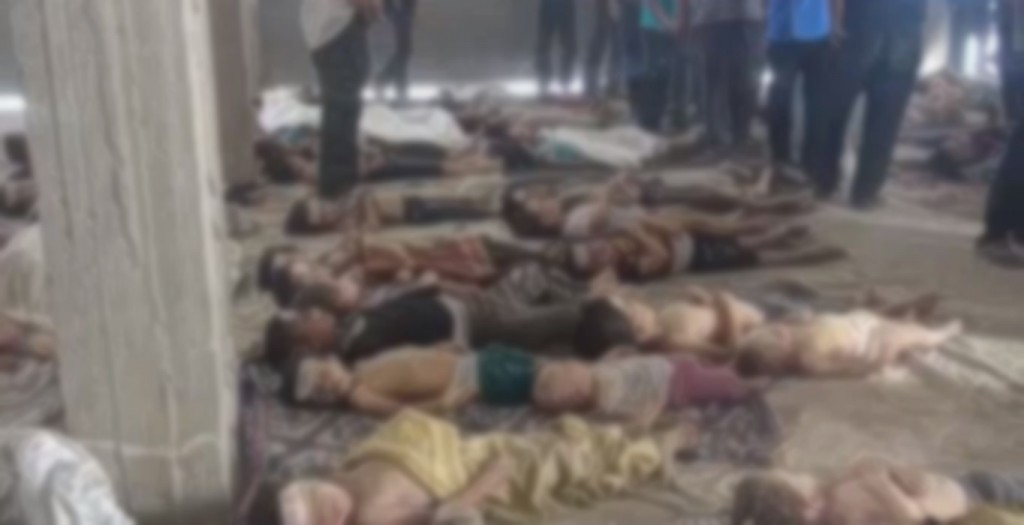
Civilians (including children) killed by the chemical attack in Ghouta. Photo: Mohammed Saeed / Wikimedia
Despite the previous chemical weapon attack, which Israel had confirmed but the United States deemed unverifiable, there was far too much carnage left in the wake of the Ghouta attack—and far too much evidence like the video of Youmna—not to address it. After the attack, Obama appeared ready to act on his stated red line, which he indicated on August 20, 2012 to be “a whole bunch of chemical weapons moving around or being utilized.” Following the Ghouta chemical weapon attack, while on a visit to Sweden, Obama stated that the U.S. “recognizes that if the international community fails to maintain certain norms, standards, laws, governing how countries interact and how people are treated, that over time this world becomes less safe.” Again, in a televised address to the American people on September 10, several days later, Obama remained consistent and clear: “If we fail to act, the Assad regime will see no reason to stop using chemical weapons. As the ban against these weapons erodes, other tyrants will have no reason to think twice about acquiring poison gas, and using them. Over time, our troops would again face the prospect of chemical warfare on the battlefield. And it could be easier for terrorist organizations to obtain these weapons, and to use them to attack civilians.”
But the seemingly imminent U.S.-led military action quickly proved ephemeral; the U.S.-Russia deal to destroy Assad’s chemical weapons arsenal was struck, and the Assad regime promised to allow for its inventory and elimination. Perhaps predictably, while the self-congratulatory Western negotiators became distracted by Assad’s partial compliance and partial foot-dragging, the regime has found increasingly creative ways to commit atrocities without the benefit of chemical weapons or renewed international threats. Assad’s “barrel bombing” campaigns and his intentional blocking of humanitarian aid are equally as indiscriminate and deadly as scuds packed with sarin—and equally justifying of intervention.
When a country is unable or unwilling to protect its own civilians, all nations have a moral responsibility to intervene and protect the innocent.
Weapons expert Elliot Higgins has exhaustively researched and documented arms used by both Syrian regime forces and rebels since early 2012. His thorough explanation of barrel bombs, which Higgins refers to as a “Do it yourself” weapon, indicates that the deadly device is a container filled with explosives, shrapnel, and fuel dropped out of the back of a helicopter, indiscriminately hitting large swaths of urban areas. The regime barrel bombings have wreaked havoc on civilian lives since August 2012 and with increasing frequency have targeted elementary schools, hospitals, and vegetable markets. In one attack on January 16, 2014, at least seven Palestinian refugees were killed and dozens more were injured when a barrel bomb struck the “Palestine Park” area of the Yarmouk refugee camp in southern Damascus—which at the time was filled with residents quite literally starving to death and eating grass to survive. On February 6, at least 15 boys were killed when a shrapnel-laden barrel bomb rained down on the Othman Bin Affan mosque, temporarily being utilized as a school in Aleppo. Too many other similar attacks exist to detail, but there has been a significant uptick in the number of barrel bombs raining down on Aleppo since world powers began to meet for peace talks with Syrian government and opposition officials on January 22. The Syrian Observatory for Human Rights (SOHR) indicates that at least 6,000 people have been brutally killed since Geneva II kicked off. From mid-January until February 14, approximately 242 Syrians have been killed per day, according to the organization.
In addition to dropping barrel bombs over civilian areas, the Assad regime has systematically blocked humanitarian aid, including food, to besieged areas of critical need. The tactic has been so effective that it has become integral to both Assad’s military strategy to drive out rebels, and his approach to negotiations with the international community. For aid workers, this campaign has destroyed most humanitarian efforts, which were already compromised by the nebulous legal boundaries of working in Syria since the conflict began. Assad’s regime has granted several organizations official approval to work within Syria—a requirement of international law—but the regime has regularly refused to actually grant visas for the aid workers of those organizations. Moreover, Assad has done absolutely nothing to ensure their safety to carry out humanitarian operations—which has played a major role in creating the unmitigated humanitarian catastrophe the UN has called “the worst humanitarian crisis in decades.”
Even before Assad choked off specific rebel-held areas to aid and food, humanitarian workers faced endless security threats. The overall radicalization of the conflict, rebel forces’ collective paranoia of foreigners, and rampant arbitrary kidnappings created a perilous environment for attempts to even began to implement aid operations. Islamist factions including the Islamic State of Iraq and Al-Sham (ISIS) publicly warned Western aid workers they would face death should they attempt to provide such services.
Italian journalist Domenico Quirico was kidnapped by Islamist rebels and held for 152 days beginning on April 8, 2013. After his release, he wrote a piece for The Guardian in which he detailed the horror:
In this place, when the hostage weeps, everyone laughs at the spectacle of his pain and sees it as a sign of weakness. Syria has become the Country of Evil, the land where evil triumphs and thrives like grapes on the vine under a Middle Eastern sun, and where evil displays all its aspects: greed, hatred, fanaticism, the absence of mercy; where even children and the old rejoice in their malevolence.
Other missing foreign nationals were swallowed up in the conflict never be to be heard from, including American journalist James Foley, whose disappearance hit an unholy one-year anniversary on November 22, 2013. Meanwhile, Doctors Without Borders (MSF) publically announced that an unidentified group kidnapped five of their European employees from their office in northern Syria on January 3, 2014; at time of writing, the employees’ conditions or whereabouts continue to remain unknown.
In all likelihood, the exact number of missing aid workers in Syria remains much higher—cocooned in secrecy by NGOs that forgo commenting on matters of missing personnel to the media in an effort to not draw attention to the uncertain grey area of legality many operate in.
These aforementioned security threats that aid workers have faced for the entirety of the conflict have now been met with cruel and deliberate sieges. Among the hardest hit by Assad’s starvation campaign is the Yarmouk Palestinian refugee camp in the southern outskirts of Damascus, where at least 18,000 people remain trapped in hellish conditions. According to SOHR, at least 85 people have died from either starvation or preventable illnesses.
If clear evidence of a chemical weapons attack and intentional starvation proved insufficient to garner—and hold—the world’s attention, one would think tens of thousands of photographs of torture would. Yet, a regime photographer has defected with 55,000 pictures in hand showcasing mutilated, emaciated bodies of prisoners who had clearly been tortured. The international community has either shrugged with apathy or meaninglessly condemned the documentation in the strongest of terms.
Discussions at Geneva II centered on opening up the besieged areas, and for several days the UN consistently delivered aid; but from February 7-16 operations were halted due to ongoing clashes and security issues. According to the UN, Islamist rebel factions have also besieged civilian areas, notably in northern Aleppo’s Nubul and Zahra areas since July 2012. Nonetheless, the Assad regime has proven capable of fiercely bombing these areas where it could have also dropped aid packages.
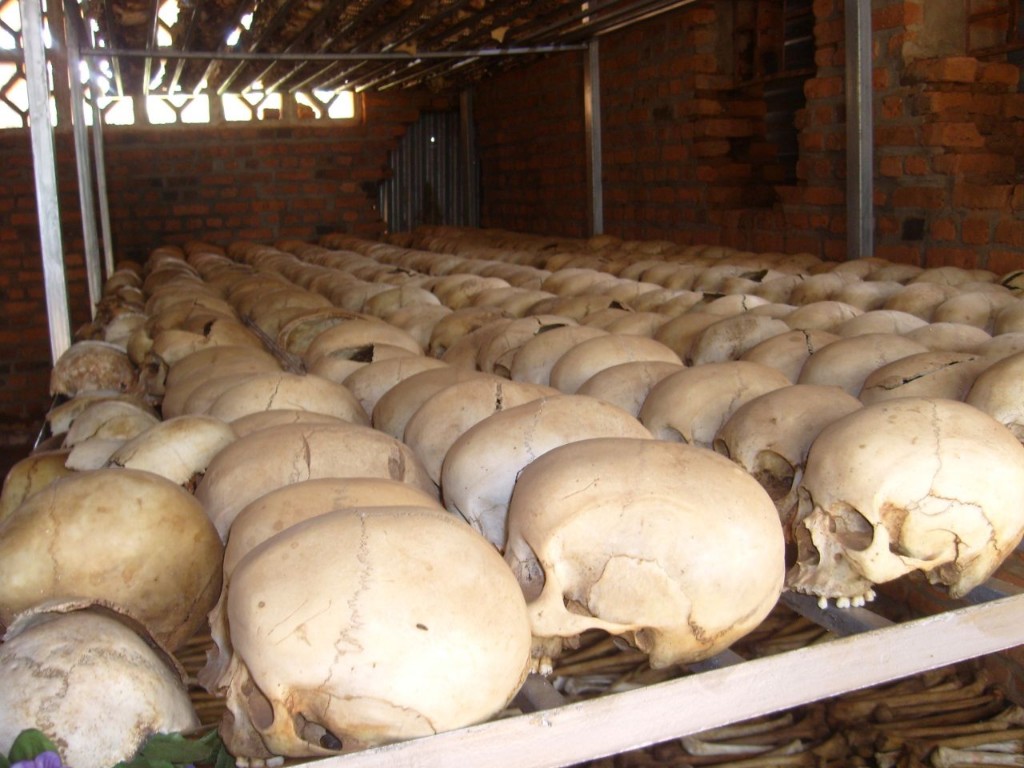
Skulls at the memorial for victims of the Ntarama Church massacre, outside Kigali, Rwanda. Photo: Robin Kirk / flickr
By cultivating such a dire humanitarian situation, the regime successfully set the agenda for Geneva II. The international community allowed the primary focus to be convincing Assad to open up besieged areas and allow for the transfer of critical goods—an absolutely imperative issue, to be sure, but one that should not be used as a bargaining chip. That humanitarian aid is being used as a negotiation tool by the regime is highly problematic for two primary reasons; the first is that the world is actively allowing Assad to hold civilians hostage, promising them aid only in exchange for concessions. The second is that it continues to allow Assad the upper hand in negotiations, which continues to tip the scales of the entire conflict in his favor. If the U.S. remains committed to supporting the future of Syria without Assad, this must not continue to happen. One modest accomplishment of the talks is that Assad allowed the evacuation of women and children from the besieged areas of Homs and allowed food into the Yarmouk camp. By doing this, he illustrated to the world that he indeed always had the control to do so—despite his claims for months that the rebels were to blame for the siege. Tit-for-tat negotiations with Assad in an effort to protect civilians without also pressuring the regime to discuss the future of Syria will only continue to prolong Syria’s suffering.
The United States and other Western powers could play a greater role in stopping the butchery in Syria by implementing humanitarian corridors (potentially in Turkish border areas), implementing a no-fly Zone over Aleppo to halt the vicious barrel bombings, and renewing efforts to engage ideologically-aligned rebels. The fear that this would significantly increase the likelihood of an attack on U.S. interests and allies ignores the fact that the Israeli Air Force has bombed within Syrian territory multiple times since the conflict begun, targeting strategic weaponry likely destined for Hezbollah hands; zero direct retaliation by the regime or by Hezbollah themselves ensued.
Further, the risk of the already-existing threat of an attack on U.S. interests only increases the longer Syria exists as a sectarian battleground. Under current conditions, Syria could become a base for al Qaeda-affiliated or -inspired jihadists in the area of the country it controls. Similarly, unsecured weaponry could fall into their hands or be transferred to Hezbollah—an ongoing issue Israel has attempted to address, to an unclear degree of success, by way of airstrikes for the last three years. Further, if the U.S. did lead efforts to implement measures to better protect civilians, Hezbollah would still likely remain deterred from striking Israel. Hezbollah cannot attack Israel without garnering a swift response that would quickly paralyze it and threaten its ongoing role in the Syrian conflict. Meanwhile, as explosives-laden cars continue to be detonated in Hezbollah strongholds of Lebanon, it has become increasingly clear the militant group is spread too thin—further decreasing the chances of retaliation against Israel.
Much has been discussed in regard to how different Syria is from Libya; it has been repeatedly asserted that the NATO intervention in 2011 holds few appropriate parallels. Syria is indeed more complicated than Libya. While Russia and China refrained from blocking a UN resolution authorizing force in Libya, they would never allow for such a resolution in Syria. However, as based on statements directly from Moscow, it is also true Russia’s response to Western intervention would be minimal. When U.S. strikes in Syria appeared imminent following the Ghouta chemical weapons attack, foreign press asked how Moscow would respond. Russian’s foreign minister, Sergei Lavrov, responded that they were “not planning to go to war with anyone” over Syria. He also condemned the potential attack as “a crude violation of international law.” The takeaway from this is that Russia remains highly unlikely to actually involve itself directly in the conflict against the U.S., and also that no one needs lessons on international law from Moscow officials.
U.S. policy inertia on Syria has been justified by referencing a supposed lack of options and the inability to distinguish a cohesive opposition to comprehensively support. Viable but inevitably imperfect options exist, but the implementation of such measures remains hinged on the decision of a war-weary Washington still haunted by major policy failures in the Middle East. It is true that Syria is not Libya. But as has been correctly pointed out, Syria is not Iraq either.
The continued failure of the international community to act is a decision to continue allowing Syria to spiral deeper into an abyss of instability, with civilians continuing to bear the brunt of the crisis. Former U.S President Bill Clinton has repeatedly said that his failure to act in the midst of the Rwandan genocide was his “greatest mistake” and a “personal failure.” President Obama’s new ambassador to the UN, Samantha Power, literally wrote the book on humanitarian intervention and America’s repeated failure to live up to its principles in its Responsibility to Protect, yet the people of Aleppo and Yarmouk and Ghouta are no safer now—in most cases worse off, as improbable as that may have seemed twelve months ago. With no end in sight as the war in Syria reaches its third year, one wonders how Americans will look back on their government’s failure to stop the most horrific atrocity of our decade.
![]()
Banner Photo: syriafreedom / flickr






